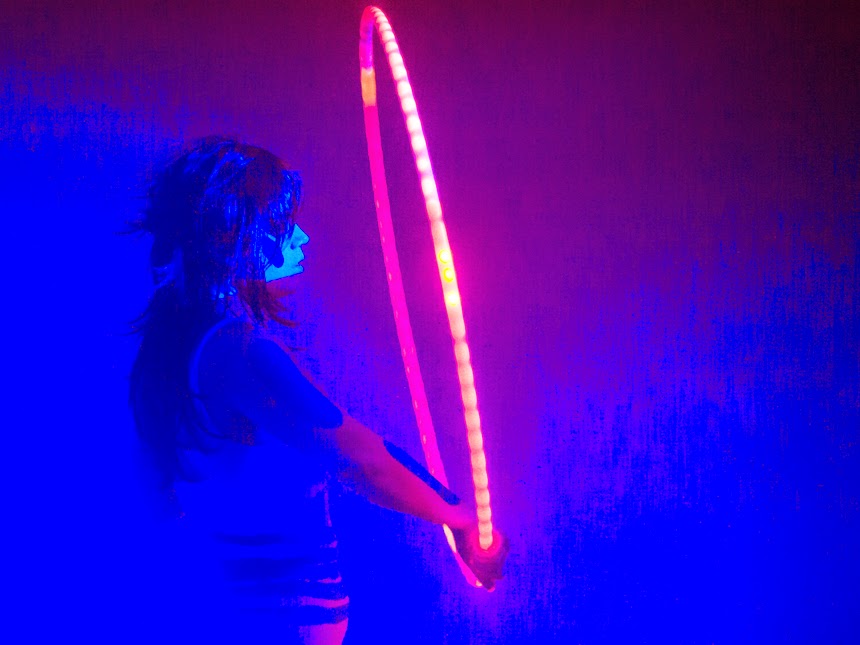A flame-engulfed, roman-slaying, chariot-riding, hula-hooping, semi-mythical queen of war. Is there anything Boudica can't do? Alicia Rodriguez investigates at Norwich OUTPOST.
Romans used wax tablets to write on, the surface of which could be
scraped, smoothed and used again. This practice of writing over erased words or
content, replacing them with new, is where the palimpsest originates.
The palimpsest as historical artefact and narrative tool is one of the starting
points for Jessica Warboys’ Boudica, a film installation and one-off
performance at Norwich OUTPOST. Boudica forms part of Invisible
Fabrick, a month-long project dealing with the elusive and relevant
relationships that run though landscape, geography, history and text. Warboys
has executed an exhibition as powerful, epic and ambiguous as the Queen of the
Iceni herself.
Throughout her practice, Jessica Warboys investigates erasure and
fluidity. Often absent from the work itself – her ongoing series of Sea
Paintings were produced largely by the drag of the tide – the artist
retains a strong sense of narrative structure. Warboys finds that familiar
place within a story that is both malleable and transitional.
While the story of
Boudica has an authority rooted in legend, its uncertainties give Warboys
license to manipulate and facilitate it. The telling itself passes
between ancient history and artist. Through Boudica, and through
Invisible Fabrick, themes of heritage and locality are considered, mediated and
revised. Landscape is crucial; what Warboys does is excavate the landscape in
order to retell, scrape clean and write over.
In 60 or 61AD, Boudica and her army of warriors ruthlessly destroyed
London, St. Albans and Colchester, killing thousands, in a revolt against Roman
rule. Her people, the Iceni, were based in what is now Norfolk and parts of
Suffolk. The story has been told again and again, revised and augmented
throughout history.
The layers of ashes and remains of buildings burnt by the
Iceni rebels that have been found underneath three cities are the only physical
evidence of Boudica’s revolt. Everything else we know is drawn from documents
written by the Romans. This has allowed for the story to metamorphose, and for
Boudica to become a figurehead of anything from war and nationalism to defiance
and rebellion. Her statue, commissioned by Prince Albert during a period when
Boudica’s legendary fame enjoyed a revival, stands next to Westminster Pier in
the city that she devastated.
 |
| Warboys performing at OUTPOST |
Boudica is a short film, looped, made up of fragments, each one documenting
abstracted elements of a narrative. It was filmed on 35mm and transferred to
digital. A hula hooper with red hair and painted with Celtic blue markings
performs fiercely and urgently in a forest clearing. It is daylight and Morten
Norbye Halvorsen’s pervasive sound design echoes a battle-march. Homemade 'props' serve as missing artefacts, false evidence shaped by their context.
They take form in a patchwork of shapes and textures, resting in the trees. In
another scene, we see a number of horses quietly grazing in the distance.
Images of the great bronze statue at Westminster are overlaid with a violent,
crackling fire.
The performer’s stare is intense, her awareness of the audience almost
intimidating. Within the aggression and theatricality carried within the
performance, there are mythic and ritualistic elements. Exploring the
imaginary, the unpretentious rural environment is a timeless place where past
events are unearthed and rewritten, re-enacted. The concept of 'retelling' is
an important one and is useful to us because the past is still in the process
of being understood. Warboys has considered this successfully by offering these
fragmented scenes and intangible representations.
Jessica Warboys worked with students from Ecole d’Enseignement Supérieur d’Art de Bordeaux to make the unusual sculptural objects that
feature in the film. Warboys suggests that the objects made outside of the
film’s context are 'imagined artefacts'[1],
which is an effective approach to these 'props': there is very little
archaeological evidence of Boudica’s rebellion and it makes sense for something
made or found by other means to form part of the storytelling. They don’t
reference any time period or place, which allows us to assign meaning to them.
They move and change with the sound of the film.
Informed by the landscape of the Boudica Way in South Norfolk, it is
not a coincidence that the exhibition takes shape in Norwich’s almost
unfailingly good OUTPOST gallery. Boudica’s presence in Norwich is subtle but
consistent. What is so exquisite about Warboys’ film is indeed the focus
on geography, and the location as palimpsest. She uses an iconic, if mysterious,
figure not simply to articulate a study of our Celtic past or even battle, or
revolt, but an exploration of ambiguity within a place. Boudica is a
perfect re-imagining of historical events because it completely emanates that
ambiguity.
Jessica Warboys and Invisible Fabrick might be a suggestion that
narrative in contemporary art continues to develop, drawing from ritual and the
imaginary. It begins with re-telling: since 60AD, Boudica has been given many
names, and I think this is a good reflection of a fluid story, not yet formed.
Alicia Rodriguez
Jessica Warboys: Boudica
2 - 21 May
Norwich OUTPOST
[1] Jessica Warboys, interview with Amy Leach




No comments:
Post a Comment